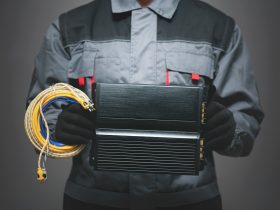If a car radio’s antenna is poorly grounded, the sound performance will undoubtedly be hindered. When you start hearing static sound from the car’s stereo and take it to a technician, chances are they will inspect the grounding system first before fixing anything.
Does a Car Radio Antenna Need to Be Grounded?
A car’s radio antenna must be grounded or else you’ll hear unwanted random sounds instead of music when you turn on the radio. As such, the antenna’s ground should be attached to the vehicle in a way that allows its voltage to connect to the earth.
Like many electric appliances, car radio antennas need to be grounded to protect them against power supply surges. By grounding the antenna, any excess voltage goes to the earth rather than bouncing back to the radio and antenna. Besides, proper grounding also helps protect other electronic components in your car.
Often, the grounding wiring for car stereos gets installed on the dashboard. It’s difficult to operate your car’s radio if the antenna isn’t grounded. The ground wire allows you to use the stereo without any malfunctions or interruptions.
How to Correctly Ground a Car Radio Antenna
Regardless of the type of electronic device you installed in your car, grounding is necessary. For example, a car radio antenna should be connected directly to the ground wire.
When you inspect the antenna area (on the hood or trunk), you’ll spot two wires running from the antenna. If you trace the single black wire, you’ll notice it doesn’t go to the car radio but rather to the chassis. This is the grounding wire that allows the radio to operate with minimal disruptions.
In some instances, the car battery’s negative terminal can be used as the grounding terminal. Nevertheless, that’s not good practice because the negative terminal’s voltage (-12 volts) is lower than the voltage on the ground (0 volts).
Likewise, the radio frequency at the negative terminal is different from that on the ground. Thus, it’s best to use the chassis rather than the car’s battery to ground the radio antenna.
It’s equally essential that the two wires running from the antenna have a clear path to the grounding point. This will prevent the voltage from bouncing back to the antenna.
Although it’s advisable to have your car radio antenna grounded by a technician, you can do the task yourself. Here are the steps to take:
- Locate the grounding wire by opening the car’s hood near the antenna. You’ll find either two or three wires running from the antenna. Typically, the black wire is the grounding wire, and you can confirm that using a multimeter.
- Follow the path of the black wire to the bolt on the chassis. Most car radio installers ground the antenna to the car’s factory grounding points.
- Using the appropriate tool, remove the bolt to check for rust. Sometimes, the car radio produces static noise because the antenna’s grounding wire bolt rusted. If that’s the case, use a wire brush or sandpaper to remove the rust. Applying dielectric grease on the grounding wire bolt keeps moisture away, thus preventing rust buildup.
- After inspecting the grounding wire, wrap its copper part on the bolt before tying it back to the frame. Afterward, you can verify its connection to the ground using a multimeter.
Grounding points on your vehicle act as a conductor between the negative and positive terminals. They allow door locks, headlights, the radio, and other electrical components to function.
If your car doesn’t come with grounding points or the available ones are not convenient for your use, you can easily create your own.
To do so, use a nut bolt to make a hole in the vehicle’s body panel. The downside of creating a grounding point using this method is that the spot might rust with time.
Nonetheless, there’s no such thing as a lousy grounding point. So the hole you create will still help you ground your car radio antenna.
Watch the following video to learn how to ground car radio antenna.
Final Thoughts
When your car radio starts to produce static noise, the first thing you’ll think about is that the stereo is spoiled. However, that’s not always the case — poor grounding of the antenna is likely the main culprit. Now you know how to fix this issue so your radio will sound the way it should.
More Related Articles:







